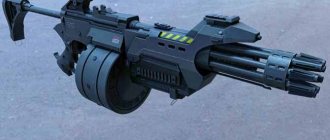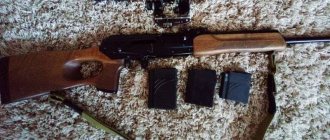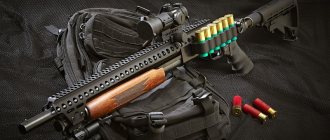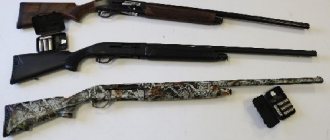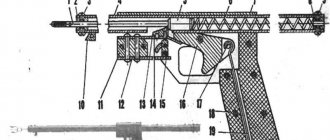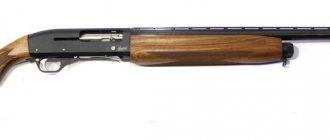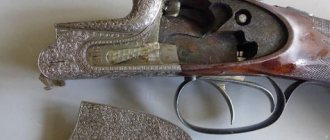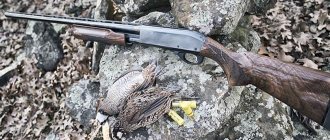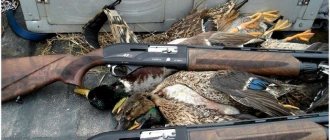The main purpose of the DTK with the “Night 9.6/53” flash suppressor for Vepr and Saiga (Tactics-Tula)
DTK (muzzle brake-compensator) with a “Night” 9.6/53 Lancaster flash suppressor is a replacement attachment for carbines produced by Molot OJSC chambered for the 411tkm (9.6x53) .366 Tkm (9.5x39) cartridge.
These include carbines VPO-223, Vepr. The product has different purposes: in the “Day” version, i.e. when installing the DTK, the device extremely effectively stabilizes the weapon during shooting, reduces the weapon's drift during rapid fire, and minimizes barrel bounce. This significantly improves accuracy. The gases are vented horizontally, so along the aiming line the flash is much smaller and does not blind the shooter. When installing an additional flame arrester casing, the “Night” option is obtained. The high efficiency of flash suppression will reveal less to the shooter, and will also allow the use of night vision sights (NVGs) or thermal imaging sights when hunting. Excellent workmanship and precise fitting dimensions allow you to independently install the device on a weapon without any problems. If you have any questions about the purpose, installation on a weapon, ordering and purchasing the “Night” flash suppressor for VPO-223 and Vepr, call the experts of our online store by phone +7. All questions can be asked directly on the website; all you need to do is fill out a small and convenient form.
9.6*53 LANCASTER
Not long ago, a new smoothbore cartridge .366TKM produced by Tekhkrim appeared on the Russian market. In 2020, we already published an article in our magazine about one model of weapon for this caliber - VPO-208, based on the OP SKS rifled weapon produced by Vyatsko-Polyansky. This weapon is popular among novice hunters, and weapon lovers are also ready to add such a rifle to their arsenal. I would not like to criticize this caliber, but, despite all its advantages, this weapon is still intended for recreational and amateur shooting. But for real hunting there is not enough power, so to speak.
But progress does not stand still, and engineers and Molot jointly developed a new caliber 9.6*53 Lancaster. This article will be dedicated to him.
Let's look at the advantages and disadvantages of this new cartridge.
Firstly, one of the most important and, in my opinion, the main thing is the opportunity to purchase rifled weapons without having five years of experience in owning a hunting smoothbore weapon. Secondly, it is the targeted shooting range and, no less important, decent results at a distance of 200 meters. The dispersion diameter when shooting at 100m gives a spread of 60mm. Decent performance for rifled weapons, not to mention smooth ones. The initial speed of a jacketed bullet weighing 14.8g is equivalent to a large rifled caliber such as 30-06 and is equal to 700m/s. The energy in the cartridge is at least 4000 J. With such a weapon, not only for shooting, but you can safely go after medium and large animals weighing up to half a ton, and know that there will be no wounded animals. Varieties of bullets in stores are currently only presented with jacketed bullets weighing 14.8 g, but manufacturers are soon planning to release shotgun, semi-jacketed, and jacketed bullets with different weights, as well as with a double jacket. The range of bullets will expand the boundaries for any hunter and weapon lover. It is equally important that there are no legal restrictions on self-assembly of such cartridges. And in the near future we will be able to see all the components for loading the 9.6*53 Lancaster cartridge in gun stores. The average price for a cartridge is 40-50 rubles, a little more than a smooth shotgun, but cheaper than a rifled one by an order of magnitude.
Below are the ballistic characteristics of some cartridges for comparison; they are united by bullet weight, muzzle velocity and power:
| Cartridge | Bullet weight, g | Initial speed, m/s | Energy, J |
| 9.6*53 Lancaster | 14,8 | 700 | 4000 |
| 9*53R Bloom | 15 | 650 | 3072 |
| 8.2*53R Sako | 13 | 750 | 3549 |
A little about Lancaster barrels.
Such barrels were first made by British engineer Charles Lancaster in the 19th century. He wanted to combine the accuracy of rifled weapons and shot shooting into one whole. And he succeeded.
The Lancaster drill is a type of smooth-bore weapon, since it does not have rifling and grooves, like a rifled weapon. If you look at the cut of the trunk, you can see an oval instead of the usual circle. And this oval is twisted throughout the barrel, due to which the bullet rotates. The pitch of the so-called rifling is an order of magnitude larger than that of a rifled weapon and is approximately 500-800mm per turn. Of course, this cannot be compared with rifled weapons. And if we compare smooth-bore weapons with the Paradox attachment, then the Lancaster barrels win, since the bullet crashes into the Paradox rifling at speed and thereby negatively affects both the weapon and the accuracy of the battle.
Currently, stores offer several models of weapons chambered for 9.6*53 Lancaster:
- VPO-220 based on the legendary Mosin rifle
- VPO-221 based on the Vepr rifled weapon
- VPO-223 based on the Jaeger rifled weapon
But manufacturers do not intend to stop there and will delight us with new models in the near future.
Text: Andreeva N.N.
Photo: Internet
Characteristics of the “Night” choke tube with DTK and flash suppressor for VPO (Tactics-Tula)
- Installation in VPO 9.6/53 Lancaster carbines.
- Military style tuning
- Matte non-glare protective paint
- Chemical oxidation, additional polymer coating
- Correspondence of fitting dimensions on the product and weapon
- No additional tool (tightening wrench) is required, as well as alteration or modification of the weapon or product
- Standard thread 16x1mm
- DTK active (partitions) and reactive (holes) type
- Compensates for part of the recoil, reduces vertical and lateral movement of the weapon barrel when firing
- Flame arrestor made of steel
- The additional casing “Night” successfully suppresses the flash when powder gases escape, made of aviation aluminum D16T
- Can be used in conjunction with night vision devices when shooting in twilight and night time
- 12 month warranty
Design features of the “Night” flame arrester
Flash suppressor "Night" on VPO 9.6/53 Lancaster. has a number of features that determine its versatility. The product consists of 2 components: a muzzle brake-compensator (DMK) and a flash suppressor casing. The DTK is made of steel and is designed for long-term operation in harsh conditions. The casing is made of aviation aluminum (D16T alloy) and is capable of withstanding high temperature loads from powder gases. Moreover, even in the maximum configuration, the weight of the product is not very large, the weapon does not overweight, does not lose balance and will cause discomfort during use. Depending on the options for installing the units, the purpose of the device changes.
Option "Day" . The choke tube is a perfectly balanced and effective 6-chamber DTK. The DTK “flute” has a calculated shape and holes taking into account the ballistics of the weapon. The shape of the holes contributes to the correct removal of some of the gases and stabilization of the carbine. The main holes divert powder gases to the sides along the horizon, reducing the risk of blinding the shooter when using an open or optical sight.
Option "Night" . When installing the casing, you get an excellent flame arrester with a closed-type afterburner chamber. Flash suppression is so effective that you can install thermal imaging or night sights and conduct targeted shooting at night without the danger of damaging or ruining the image intensifier (electron-optical converter) matrix of your optics. The problem of unmasking when shooting when hunting at night disappears.
Installation sequence
- Unload the weapon, remove the magazine and make sure there is no cartridge in the chamber
- Put the weapon on safety and check again that the weapon is unloaded
- If there is a choke tube, dismantle it (or unscrew the nut on the cut of the barrel)
- Screw the locknut onto the barrel until it stops, and then the DTK itself
- It is MANDATORY to check the alignment of the bore and DTK. If there is no alignment, the operation of the weapon is prohibited!
- Screw the flame arrester casing onto the external thread of the DTK until it stops. Secure it using a socket screw (key included)
- Install the afterburner chamber cover.
.
Important information!
When the casing is on, this product has an external resemblance to a PBS (silent shooting device). Technically and structurally, the flame arrester has nothing in common with these devices and is manufactured in full compliance with the norms of the Federal Law of the Russian Federation “On Weapons”
When the casing is installed, firing in bursts is prohibited!
Contents of delivery:
- Flame arrestor – 1 pc.
- Additional casing “Night” - 1 pc.
- Casing cover – 1 pc.
- Tube packaging
Tested in the USSR. Avro Lancaster heavy bomber
Home » Books on aviation history » Tested in the USSR. Avro Lancaster heavy bomber
Aviation history booksControversial history of the recent past
byakin 02/12/2019 1500
17
in Favoritesin Favoritesfrom Favorites 7
This article by Vladimir Kotelnikov, published back in 1992, is posted as a supplement to the article by his respected colleague Serg, “Planes of alternative air forces.”
During the Great Patriotic War, Soviet aviation was in dire need of the supply of heavy bombers. The country's aircraft factories, overloaded with the production of tactical aircraft, could not provide the Air Force with any significant fleet of large multi-engine aircraft. The only domestic heavy bomber, the Pe-8, built in 1941-44, was produced in only 79 copies.
Very few such vehicles came to us through official channels of assistance from the allies - one American B-24D Liberator and several British Stirlings. Nevertheless, at the end of the war and in the first post-war years, our Air Force was armed with a number of British and American-made heavy bombers from those restored after forced landings or interned in the Far East. Among them were aircraft of the Avro Lancaster type. The history of their appearance in our country is as follows.
In September 1944, the Soviet and British commands launched the joint Operation Paravan against the German battleship Tirpitz, which was defending itself in Altenfjord on the coast of Norway. The battleship had previously been damaged several times, but continued to remain a potential danger on the route of northern convoys from England to the Soviet Union. During the operation, 38 Lancasters, 2 Liberator transports and one Mosquito reconnaissance aircraft were sent to the Yagodnik airfield in the Arkhangelsk region.
The formation, assembled from aircraft 6 of the 17th and 9th Bomber Squadrons of the Royal Air Force, was equipped with Lancasters of modifications I (with Rolls-Royce Merlin 24 engines) and III (with Packard Merlin 224 engines), specially adapted for suspension of super-heavy bombs weighing 12,000 lb (5,450 kg). Externally, they differed from the standard ones in having a recessed “pot-bellied” bomb bay and the absence of an upper FN50 turret.
Lancaster in the USSR
From 6 a.m. on September 12, British planes began landing at the airfields of the Arkhangelsk hub. For various reasons, 10 bombers made emergency landings in Onega, Belomorsk, Kegostrov, Molotov (Severodvinsk) and simply in the tundra. One car landed in such an inconvenient place that it was necessary to drop a parachutist-guide, who led the crew to the river, where the MBR-2 flying boat was waiting. 7 aircraft were damaged, one of them was repaired by our and British specialists.
On September 15, 27 Lancasters (including the repaired one) bombed the Tirpitz. Our navigators led them to the target. Soviet planes also conducted preliminary reconnaissance and then photographed the results of the raid. Of the 21 super-powerful Tellboy bombs (six vehicles carried conventional armor-piercing bombs of 224 kg each), one hit the battleship directly, and several smaller ones also hit the target. However, Tirpitz remained afloat. The British had no losses.
From September 16 to 28, all serviceable Lancasters returned to their bases in the UK. Subsequently, they still managed to finish off the Tirpitz, which the Germans moved to a new location - near Haak Island.
There were six damaged Lancasters left on Soviet soil - one Lancaster III and five Lancaster Is. Four of them were examined for possible restoration. The two least damaged ones were taken to Kegostrov, where in the workshops of the Air Force of the White Sea Military Flotilla, under the leadership of Chief Engineer Kiryanov, they began to repair and remodel them.
All weapons were removed from them, the rear turret was sewn up with duralumin sheets. The damaged nose section was changed: the old “stepped” nose with a gun mount was replaced with a new transparent fairing. The coloring remained the same, English (brown-green top and black bottom), only the identification marks were painted over with our green paint (which differed in tone) and red stars with a black border were applied on top. Both cars were redesigned in the same way.
One of them, with the number “01”, went to the 16th transport detachment (trao), where it was operated from the end of January 1945 (presumably it was an aircraft with the number ME559, produced). The aircraft commander was V.Sh. Evdokimov, the navigator was V.Ya. Andreev. The 16th Trao was the heir to the famous 2nd separate air group of I.T. Mazuruk, formed at the beginning of the war from polar pilots. Although it was called transport, it was used not only and not so much for transporting people and goods, but for escorting convoys, ice reconnaissance, and patrolling. The Lancaster also flew to search for submarines (although it carried neither bombs nor small arms), and to reconnaissance of remote areas, where its long range and flight duration were very valuable. For example, on January 24, Lancaster conducted ice reconnaissance of the Beluzhya Bay (Novaya Zemlya) - Naryan-Mar section.
Our Lancaster crew consisted of 4-5 people: one or two pilots, a navigator and two mechanics.
Lancaster B.Mk.I converted into a transport aircraft. 16th troop air force of the White Sea military flotilla, 1945
In August 1945, this vehicle was sent to the Pacific Ocean, but it was stuck in Krasnoyarsk due to a lack of fuel. While we were waiting for gasoline, the war with Japan ended. In the summer of 1946, this Lancaster was transported to Riga, to the Aviation Technical School, as a visual aid. His further fate is unknown.
The second restored Lancaster, numbered “02”, ended up in the 70th separate transport regiment (squad) of the Northern Fleet Air Force. The commander of this vehicle was I.I. Dubenets. After the disbandment of the 16th Trao in 1946, both aircraft were briefly together in the 70th Motrap; after the war, “02” was crashed while landing at the airfield in Izmailovo, Moscow. The bomber rolled off the airfield, broke the landing gear and mutilated the nose. They didn’t restore it again - they wrote it off.
Of course, two planes could not change the course of the war. However, it must be pointed out that, unlike the B-17 and B-24, which never took part in combat operations with Soviet crews, the Lancasters with red stars managed to make a significant number of combat missions, although they did not meet the enemy "face to face", and thus contributed to the overall victory.
source: Vladimir Kotelnikov “World of Aviation” 01/1992

